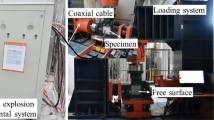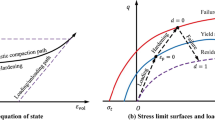Abstract
This paper presents a comprehensive study on the numerical and experimental simulation of smooth blasting in limestone. The calibration of the numerical model was initiated through Brazilian and uniaxial compression tests on limestone samples. Compressive strength and Brazilian tensile strength of limestone were 70 MPa and 8 MPa. This enabled the determination of essential micro-parameters. Subsequently, smooth blasting scenarios were simulated under two distinct conditions: with and without confinement. Under confinement conditions, models with dimensions of 600 mm * 900 mm were constructed. The blasting hole was strategically positioned at varying distances from the free boundary, accompanied by a row of parallel holes positioned behind it. A confining pressure of 10 MPa was applied. Appropriate values for normal and shear damping, as well as the allocation of a viscous boundary, were established. Normal and shear damping values were equal to 0.4 and 0.3, respectively. Throughout different stages of blasting, critical parameters such as crack growth patterns, particle velocity, and induced loads near the blasting hole were meticulously recorded. Measuring circles were strategically placed in proximity to both the blasting hole and free boundary to capture induced forces. Parallel to the numerical simulations, an unconfined experimental test was conducted on limestone samples with similar dimensions. However, it was observed that the reflected tensile stress wave at the surface of the empty hole exacerbated damage to the rock mass between the blast hole and the empty holes. The presence of multiple empty holes significantly influenced the extension of the blasting-induced main fracture. Various factors, including the distance between the explosion source and the empty holes, played a pivotal role in the reflection tensile failure on the surface with no holes. Furthermore, it was found that increasing the separation between the empty holes and the blasting hole led to a reduction in kinetic energy and high friction energy. Conversely, widening the blasting holes amplified both peak friction energy and kinetic energy. Elevating the confining pressure resulted in a decrease in both peak friction energy and kinetic energy, while simultaneously increasing the strain energy. Additionally, extending the distance between the blasting hole and the free border led to a reduction in flying rock. Confining the area had a dual benefit of reducing induced force and mitigating the quantity of flying rock. The results from the experimental test and numerical simulation exhibited a consistent trend.

























Similar content being viewed by others
References
Berta G (1990) Explosives: an engineering tool. LA Moderna, Novara, pp 96–108
Li C, Kang Y, Zhang Y, Luo H (2021) Effect of double-holes on crack propagation in PMMA plates under blasting load by caustics method. Theor Appl Fract Mech 116:103103. https://doi.org/10.1016/j.tafmec.2021.103103
Yang J, Sun W, Yao C, Zhang X (2020) Mechanism of rock fragmentation by multihole blasting in highly-stressed rock masses. Explos Shock Waves 40(7):075202
Chen S, Hu S, Chu S (2017) Study on the blasting vibration effect influenced by millisecond time and cylindrical charging characteristics. Chin J Rock Mech Eng 36:3974–3983
Guo D-Y, Zhao J-C, Zhu T-G, Zhang C (2020) Crack propagation and coalescence mechanism of double-hole cumulative blasting in coal seam. Chin J Eng 42:1613–1623
Yang L, Ding C, Yang R, Wang Q (2020) Experimental and theoretical analysis of stress superposition in double-hole blasts. J Test Eval 48:20180093
Pu C, Yang X, Zhao H, Chen Z, Xiao D (2021) Numerical investigation on crack propagation and coalescence induced by dual-borehole blasting. Int J Impact Eng 157:103983
Wu B, Xu S, Meng G, Cui Y, Cai J, Zhang Y (2021) Study on the dynamic evolution of through-crack in the double-hole of elliptical bipolar linear-shaped charge blasting. Shock Vib 2021:3792765. https://doi.org/10.1155/2021/3792765
Chen H, Qiu X, Shi X, Zhang J, Huo X, Li D (2022) Experimental study on fracturing characteristics of double-hole blasting under static stresses. Front Earth Sci 9:829258
Zhang J, Liu Z, Fu S, Qiao G (2022) Damage of rock mass by double-hole blasting with slit charge and development of stress wave under high in situ stress. Shock Vib 2022:6967057. https://doi.org/10.1155/2022/6967057
Shen S, Zhao Y, Liu C, Dai S, Wu F, Jiang M (2021) Penetration form of inter hole cracks under double-hole blasting conditions with inclined fissures. Adv Civ Eng 2021:6677595
Dong M, Wang L, Shahbodagh B, Du X, Deng S, Sun Z (2020) Effect of the soft and hard interbedded layers of bedrock on the mechanical characteristics of stabilizing piles. Appl Sci 10(14):4760
Qian D, Xinping L, Yongsheng J, Jinshan S (2021) A numerical simulation of blasting stress wave propagation in a jointed rock mass under initial stresses. Appl Sci 11:7873
Sun N, Lei M, Zhang Y, Su G, Huang G (2020) A study on the influence of weak interlayer on the propagation process of explosion stress wave. J Vib Shock 39(112–119):147
Zhou H, He C (2020) Propagation law of stress wave and cracks in non-penetrating jointed rock mass: a numerical study based on particle flow code. Geotech Geol Eng 38:3967–3981
Chen Y, Chang Z, Mao J, Wang W (2015) Blasting effect analysis of hole-by-hole millisecond minute difference initiation network along V-Shaped oblique line. Electron J Geotech Eng 20:5833–5838
Yang S-Q, Chen M, Fang G, Wang Y-C, Meng B, Li Y-H, Jing H-W (2018) Physical experiment and numerical modelling of tunnel excavation in slanted upper-soft and lower-hard strata. Tunn Undergr Space Technol 82:248–264
Feng W, Huang R, Li T (2012) Deformation analysis of a soft–hard rock contact zone surrounding a tunnel. Tunn Undergr Space Technol 32:190–197
Chen L, Fan S, Zhao C, Zhang L, Cheng Z (2019) Calculation method of overburden damage height based on fracture mechanics analysis of soft and hard rock layers. Geofluids 2019:3790264
Yaylacı EU, Oner E, Yaylacı M, Ozdemir ME, Abushattal A, Birinci A (2022) Application of artificial neural networks in the analysis of the continuous contact problem. Struct Eng Mech 84(1):35–48
Yaylacı M, Abanoz M, Yaylacı EU, Ölmez H, Sekban DM, Birinci A (2022) The contact problem of the functionally graded layer resting on rigid foundation pressed via rigid punch. Steel Compos Struct 43(5):661–672
Özdemir ME, Yaylacı M (2023) Research of the impact of material and flow properties on fluid-structure interaction in cage systems. Wind Struct 36(1):31–40
Yaylacı M, Uzun Yaylacı E, Ozdemir ME, Ozturk S, Sesli H (2023) Vibration and buckling analyses of FGM beam with edge crack: finite element and multilayer perceptron methods. Steel Compos Struct 46(4):565–575
Yaylacı M, Öner E, Adıyaman G, Öztürk Ş, Uzun Yaylacı E, Birinci A (2023) Analyzing of continuous and discontinuous contact problems of a functionally graded layer: theory of elasticity and finite element method. Mech Based Des Struct Mach. https://doi.org/10.1080/15397734.2023.2262562
Golewski GL (2023) Mechanical properties and brittleness of concrete made by combined fly ash, silica fume and nanosilica with ordinary Portland cement. AIMS Mater Sci 10(3):390–404
Golewski GL (2023) Concrete composites based on quaternary blended cements with a reduced width of initial microcracks. Appl Sci 13(12):7338. https://doi.org/10.3390/app13127338
Golewski GL (2023) Study of strength and microstructure of a new sustainable concrete incorporating pozzolanic materials. Struct Eng Mech 86(4):431–441
Golewski GL (2023) Effect of coarse aggregate grading on mechanical parameters and fracture toughness of limestone concrete. Infrastructures 8(8):117. https://doi.org/10.3390/infrastructures8080117
Dai J (2005) Blasting engineering. China Machinery Industry Press, China, Beijing
Shi C, Li D, Chen K, Zhou J (2016) Failure mechanism and stability analysis of the Zhenggang land slide in Yunnan Province of Chinausing3D particle flow code simulation. J Mt Sci 13(05):891–905
Yang XX, Jing HW, Chen KF, Yang SQ (2017) Failure behavior around a circular opening in a rock mass with non-persistent joints: a parallel-bond stress corrosion approach. J Cent South Univ 24(10):2406–2420
Wang P, Ren F, Cai M (2020) Influence of joint geometry and roughness on the multiscale shear behavior of fractured rock mass using particle flow code. Arab J Geosci 13:165
Cundall PA, Strack D (1979) A discrete numerical model for granular assemblies. Geotechnique 29(1):47–65
Potyondy DO, Cundall PA (2004) A bonded-particle model for rock. Int J Rock Mech Min Sci 41(8):1329–1364
Cho N, Martin CD, Sego DC (2007) A clumped particle model for rock. Int J Rock Mech Min Sci 44(7):997–1010
Shi C (2015) Technique and practice of particle flow numerical simulation. China Architecture Industry Press, China, Beijing
Ning J (2010) Explosionand impact dynamics. National Defense Industry Press, China, Beijing
Lysmer J, Kuhlemeyer RL (1969) Finite dynamic model for infinite media. J Eng Mech 95(4):859–877
Yuan W, Wang W, Su XB, Li JX, Li ZH, Wen L, Chang JF (2018) Numerical study of the impact mechanism of decoupling charge on blasting-enhanced permeability in low-permeability sandstones. Int J Rock Mech Min Sci 106:300–310
Ghazvinian A, Sarfarazi V, Schubert W, Blumel M (2012) A study of the failure mechanism of planar non-persistent open joints using PFC2D. Rock Mech Rock Eng 45(5):677–693
Sarfarazi V, Abharian S, Ghorbani A (2021) Physical test and PFC modelling of rock pillar failure containing two neighboring joints and one hole. Smart Struct Syst 27(1):123–137
Potyondy DO (2012) A flat-jointed bonded-particle material for hard rock. In: Proceedings of the 46th U.S. rock mechanics/geomechanics symposium, Chicago, USA
Author information
Authors and Affiliations
Corresponding author
Ethics declarations
Conflict of interest
The authors have no conflict of interest to declare that are relevant to the content of this article.
Additional information
Publisher's Note
Springer Nature remains neutral with regard to jurisdictional claims in published maps and institutional affiliations.
Rights and permissions
Springer Nature or its licensor (e.g. a society or other partner) holds exclusive rights to this article under a publishing agreement with the author(s) or other rightsholder(s); author self-archiving of the accepted manuscript version of this article is solely governed by the terms of such publishing agreement and applicable law.
About this article
Cite this article
Sarfarazi, V., Fu, J., Haeri, H. et al. Investigation of fracture mechanisms in smooth blasting of limestone samples: numerical and experimental approaches. Comp. Part. Mech. (2024). https://doi.org/10.1007/s40571-024-00764-5
Received:
Revised:
Accepted:
Published:
DOI: https://doi.org/10.1007/s40571-024-00764-5




